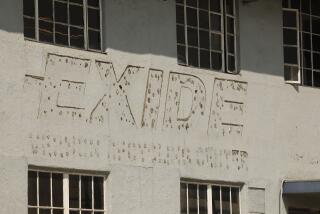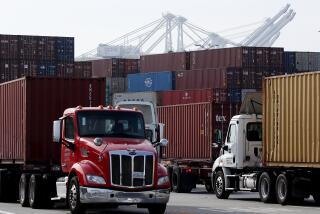S.F. to Be Port for Foreign Nuclear Waste
- Share via
SACRAMENTO — A seemingly ordinary transport ship is scheduled to steam into California waters next month, carrying a decidedly extraordinary cargo--highly radioactive nuclear waste from Asia.
From the shores of the choppy San Francisco Bay, the load will travel by train 918 miles through densely populated cities, several narrow canyons and onward to Idaho, where it will come to rest at a federal storage site.
That trip is part of a little-noticed federal effort that is once again making the United States a dumping ground for dangerous foreign nuclear waste. Already, more than half a dozen foreign shipments have been transported through the port in Charleston, S.C., for storage on the East Coast.
The goal is to keep highly enriched uranium, the key ingredient in a nuclear bomb, out of the hands of terrorists and rogue nations. But the effort has drawn fire from anti-nuclear activists and Bay Area lawmakers who consider the shipments a perilous import to their home territory.
Now the state Coastal Commission has joined the fray, pushing to block the five shipments scheduled to dock over the next decade at the Bay Area’s Concord Naval Weapons Station. The state agency has demanded a chance to review the federal plans.
Officials at the U.S. Department of Energy, which is shepherding the program, have refused the commission’s request. The department’s scientists say the chances of a catastrophic accident that would release enough radiation to harm humans or sea life are literally a billion to one.
No matter how remote, though, commission officials worry that an accident could wreak harm on the state’s commercial and recreational fishing industries, creating public perception problems even if no radiation was released. It would make more sense, they say, to divert the five Bay Area shipments to Charleston, which is slated to get more than 200 shipments in the coming years.
“One has to take these assertions of safety with a sizable grain of skepticism,” said Peter Douglas, Coastal Commission executive director. “It’s been said before that something is foolproof, then lo and behold, the unthinkable happens.”
Federal officials, who have defeated several lawsuits to block the shipments, are ready to fight again if the commission pushes the issue to court.
“We believe we’ve demonstrated that the risks are extremely low,” said David Huizenga, a deputy assistant secretary for nuclear materials. “This is a NIMBY issue. Most people support the overall policy of bringing this material back here, they just don’t want it to go through their backyards.”
The shipments date back more than four decades.
During the early 1950s, the Eisenhower administration launched its Atoms for Peace program. It was designed as a trade-off: Foreign nations were supplied with nuclear research reactors and fuel in exchange for a promise not to develop atomic weapons. Part of the deal, federal officials say, was that the United States would take back the spent fuel.
For decades, the used uranium was returned through U.S. ports on both coasts, but under the cloak of secrecy. That changed in the 1980s, as environmental groups that had learned of the imported nuclear waste called for reviews of the program. Between 1988 and 1994 the program ceased while the federal government conducted an analysis.
The shipments resumed in 1994 into Charleston, where the spent nuclear fuel travels on to the government’s Savannah River site in Aiken, S.C.
In all, Savannah River will get 19 metric tons, while 1 ton will go through the Bay Area. That’s dwarfed by the 30,000 metric tons of domestically produced nuclear waste now in storage.
Travel Plans Under Protest
West Coast foes say the Bay Area shipments will travel a perilous route.
Once under the Golden Gate, the nuke-toting cargo ship will pass numerous oil refineries and navigate the roiling Carquinez Straights to reach the Concord naval base. The train trip winds through metropolitan areas, including Sacramento, before heading into the steep canyons lining the Feather River.
The canyons, foes say, could prove particularly dicey. During a 15-year period ending in 1991, there were 28 derailments because of rockslides on the treacherous route. Retaining walls have been beefed up, but last month two train cars were swept off the tracks by a slide, sending a cargo of wine and tequila tumbling over the edge. A second slide a few weeks ago threw VW-sized boulders across the tracks.
Federal official say every precaution is being taken.
The cargo ship will be circled by Coast Guard craft when it arrives at the California coast. The train will be heavily guarded and monitored along the route by more than 2,000 emergency personnel. Steep canyon sides are being surveyed. The railroad bed and ties have been upgraded, and a special surveillance rig will travel the line to ensure that the tracks are true.
Even if the worst happened, federal officials are confident that the steel container casks could survive. With half-foot steel walls, the casks look like gigantic dumbbells. They have survived tests that include being hit by a freight train at more than 80 mph, dropping out of an airplane at 2,000 feet and getting toasted by 1,400-degree flames for 90 minutes.
Federal confidence is further bolstered by the Energy Department’s record in nuclear shipments. Of more than 2,500 trips over the decades, officials say, there have been a half-dozen accidents but no release of radiation from the casks.
They also say that shipments of nuclear waste into California are not unusual. The Navy secretly transported spent nuclear fuel on 84 occasions into the Bay Area between 1962 and 1995, Energy Department officials say. About half continued on by train along the Feather River route.
Shortest Route Between Two Points
Huizenga, the department’s deputy for nuclear materials, said the plan was born out of geographic reality. From Asia, the most direct route to the Idaho storage site is via the West Coast, he said. “We’re just looking at the globe and figuring the shortest way to get to a treatment facility.”
Energy Department officials say even if one of the nuclear casks somehow broke open at sea or on land, it would be far from catastrophic. In the ocean, the effect on marine life “would be minimal,” federal officials say. On land, any spill could be quickly mopped up.
The Coastal Commission’s Douglas isn’t mollified. He points to the federal nuclear facility in Hanford, Wash., where a $1 billion-a-year cleanup continues after Energy Department officials vowed that liquid atomic waste wouldn’t seep into the ground water.
“This is the same outfit that told us it wasn’t going to happen up there,” Douglas said. “I hope they’re right, that there’s no real danger here. But at the same time I think we have to be super-cautious.”
Anti-nuclear activists say the federal effort is wrongheaded. They argue that many of the countries where the uranium is now stored--among them Sweden and Japan--are no less stable than the United States. The material should stay there under guard, they say, and foreign research reactors built during the Eisenhower years should be shut down for good.
“They haven’t demonstrated that it’s any more dangerous to leave it there than to bring it here,” said Jacqueline Cabasso, executive director of the Western States Legal Foundation, an anti-nuclear group. “What we have is a nuclear shell game.”
Federal officials, however, say there are no guarantees that the spent fuel won’t fall into the wrong hands.
In particular, State Department officials are eager to retrieve uranium from Korea and other hot spots. Federal officials also had planned to make spent fuel stored in Indonesia an early priority, but had to delay plans after civil unrest broke out in the island nation.
“Frankly, we don’t have any real control over what happens in these countries,” Huizenga said. “It should be pretty obvious with the instability in Indonesia that this can be a problem. This material is safest on U.S. soil.”
More to Read
Sign up for Essential California
The most important California stories and recommendations in your inbox every morning.
You may occasionally receive promotional content from the Los Angeles Times.









